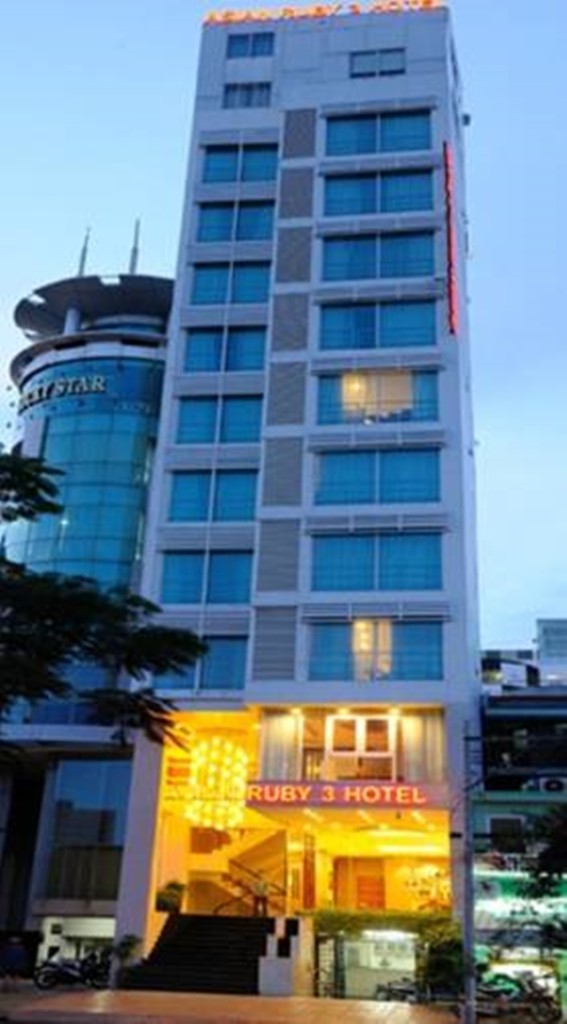Southeast Asia with Peter – Day 11
We left Saigon early in the morning and headed by bus south to the city of Chau Doc on the Mekong river delta. Here are a few early morning street scenes. The unlicensed selling of food on the street is illegal. I think someone forgot to tell these women…


 We passed this row of buildings across a canal. They are an apartment block. Henry described typical one floor Saigon apartments: They are about 12 to 15 fee wide and about 50 to 60 feet deep. That’s about 600 to 900 square feet. Not very big by our standards, but Saigon is very crowded.
We passed this row of buildings across a canal. They are an apartment block. Henry described typical one floor Saigon apartments: They are about 12 to 15 fee wide and about 50 to 60 feet deep. That’s about 600 to 900 square feet. Not very big by our standards, but Saigon is very crowded.
Even our Asian Ruby 3 hotel was narrow. One room wide and 5 rooms deep!
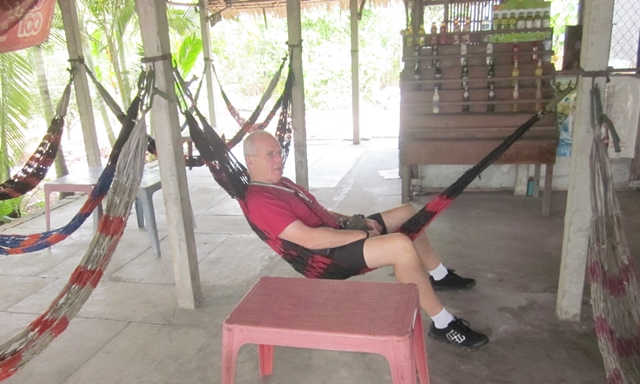 After about an hour of driving, we had a rest stop In Vietnam, a typical roadside rest stop is a veranda with hammocks. You buy food or a drink and stretch out for a snooze. This is Jerry Ashley from CA. He was traveling with his wife Donn (picture later). They we experienced travelers and did a lot of sight seeing on their own.
After about an hour of driving, we had a rest stop In Vietnam, a typical roadside rest stop is a veranda with hammocks. You buy food or a drink and stretch out for a snooze. This is Jerry Ashley from CA. He was traveling with his wife Donn (picture later). They we experienced travelers and did a lot of sight seeing on their own.
 While Jerry was “resting”, Ole and I had a glass of coffee. This was brewed in a little aluminum drip thing into a small glass with a scoop of sugar and some sweetened condensed milk to smooth it out. Pete had fresh coconut water in the original container. Mary looked on.
While Jerry was “resting”, Ole and I had a glass of coffee. This was brewed in a little aluminum drip thing into a small glass with a scoop of sugar and some sweetened condensed milk to smooth it out. Pete had fresh coconut water in the original container. Mary looked on. We needed a trip to the “happy room” after that coffee.
We needed a trip to the “happy room” after that coffee.
Here is the proprietor‘s home. He allowed us to come in a take photos.
The proprietor and his daughter Their house shrine
Their house shrine His son on a bed. Note the bug zapper and mats (in the back).
His son on a bed. Note the bug zapper and mats (in the back).
 Their kitchen and rice storage crock.
Their kitchen and rice storage crock.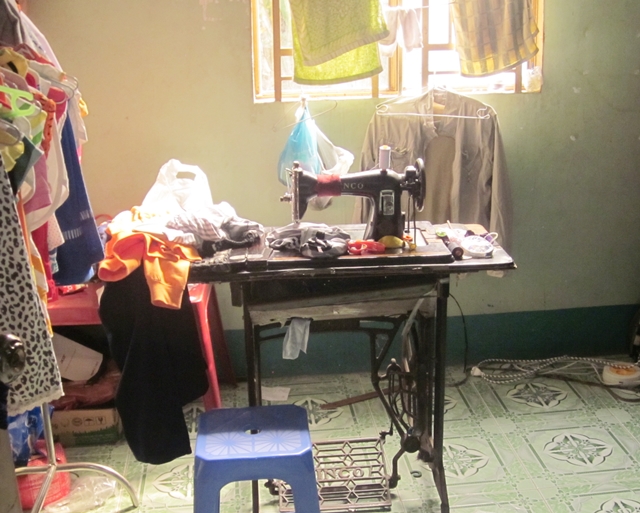
 Their sewing room and computer room.
Their sewing room and computer room.
 And, finally, their fighting cock!
And, finally, their fighting cock!
On a more somber note: We stopped at a Vietnam (American) War Cemetery:
The Memorial Stele I’ve been to many war cemeteries in the US and Europe and I always get a little chocked up think about the young men and women who violently gave up their lives for their country. It’s very sad to lose so many unlived lives.
I’ve been to many war cemeteries in the US and Europe and I always get a little chocked up think about the young men and women who violently gave up their lives for their country. It’s very sad to lose so many unlived lives.
These graves are marked with a white structure with a head stone with names and dates. The body is not in the white structure, but is buried below it. This section of the cemetery is being restored. The man below is cleaning head stones.
This section of the cemetery is being restored. The man below is cleaning head stones. 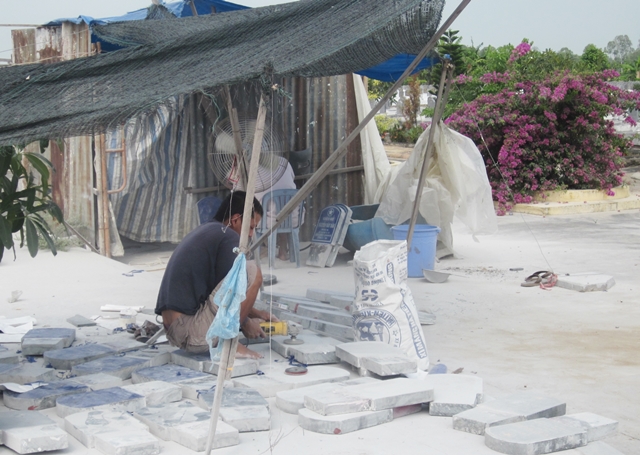
The pictures below are places we passed as we crossed the many villages, canals and distributaries of the Mekong delta: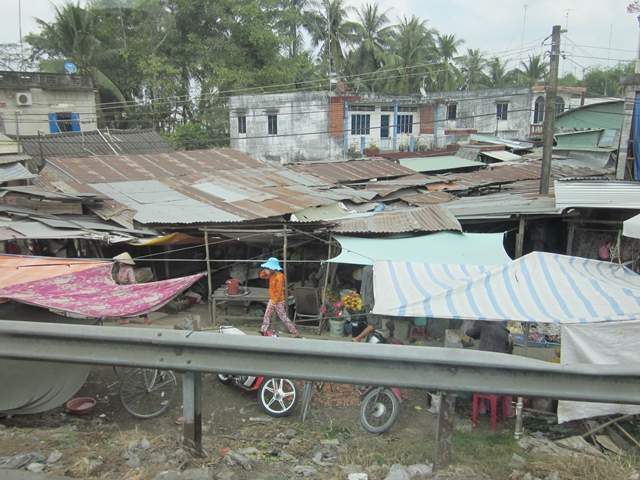








We made another stop at a the Sau Xe candy shop in the village of Sa Dec. We used the “happy room” (western) and bought snacks to keep us going. I bought some durian candy, it didn’t taste like I thought durian should taste like. The green packages contained sweetened “sticky rice” a local confection.
The green packages contained sweetened “sticky rice” a local confection. This is a picture of a Vietnamese school girl wearing an Ao Dai.
This is a picture of a Vietnamese school girl wearing an Ao Dai.
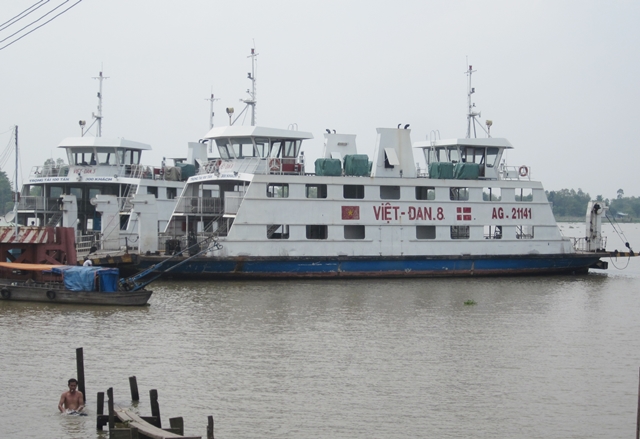

 We crossed the Mekong at Long Xuyen and had lunch at the Dong Xuyen hotel. This little feller is having his lunch on the ferry.
We crossed the Mekong at Long Xuyen and had lunch at the Dong Xuyen hotel. This little feller is having his lunch on the ferry.
Here’s our lunch menu. It is typical of most meals: fish, chicken, pork, and fruit for dessert. The fish probably came from a Mekong fish farm.
 Our next stop was a visit to the Cao Dai temple. Cao Đài is a relatively modern syncretistic, monotheistic religion, officially established in the city of Tây Ninh, southern Vietnam in 1926. Due to its young age, it shows its syncretistic roots more than older religions (Syncretism is the combining of different, often seemingly contradictory beliefs.).
Our next stop was a visit to the Cao Dai temple. Cao Đài is a relatively modern syncretistic, monotheistic religion, officially established in the city of Tây Ninh, southern Vietnam in 1926. Due to its young age, it shows its syncretistic roots more than older religions (Syncretism is the combining of different, often seemingly contradictory beliefs.).
The noble effort of Cao Dai is to unite all of humanity through a common vision of the Supreme Being, whatever our minor differences, in order to promote peace and understanding throughout the world. Cao Dai does not seek to create a gray world, where all religions are exactly the same, only to create a more tolerant world, where all can see each other as sisters and brothers from a common divine source reaching out to a common divine destiny realizing peace within and without. ‘Nuff said?
 Above the door is “The All Seeing Eye” This is the visual symbol used by Cao Dai followers for their Supreme Being. I wonder if it means the same as The All Seeing Eye on our US $1 dollar bills: Annuit Cœptis “He [God] has favored our undertakings”. Hmmmmm…
Above the door is “The All Seeing Eye” This is the visual symbol used by Cao Dai followers for their Supreme Being. I wonder if it means the same as The All Seeing Eye on our US $1 dollar bills: Annuit Cœptis “He [God] has favored our undertakings”. Hmmmmm…
 We weren’t there for this gathering of the faithful, but it’s impressive!
We weren’t there for this gathering of the faithful, but it’s impressive!
Of course, no ceremony would be complete with a “Naga”.
 Here’s our guide Henry giving us a run down of Cao Dai. It was followed by a practitioner doing all the bowing ands scraping that is part of their ritual
Here’s our guide Henry giving us a run down of Cao Dai. It was followed by a practitioner doing all the bowing ands scraping that is part of their ritual
Lao Tze, Buddha, Confucius and are Jesus Christ above the altar.
A mural inside the temple commemorates French novelist Victor Hugo, Chinese Nationalist Party leader Sun Yat Sen and Vietnamese poet Trang Trinh as three of their saints.
This guy was guarding the door to keep heathens like myself out, He didn’t scare me a bit!! As we drove away from the temple I got this shot of Peter meditating.
As we drove away from the temple I got this shot of Peter meditating.
We visited a family operated brick factory. Fun for the whole family!!
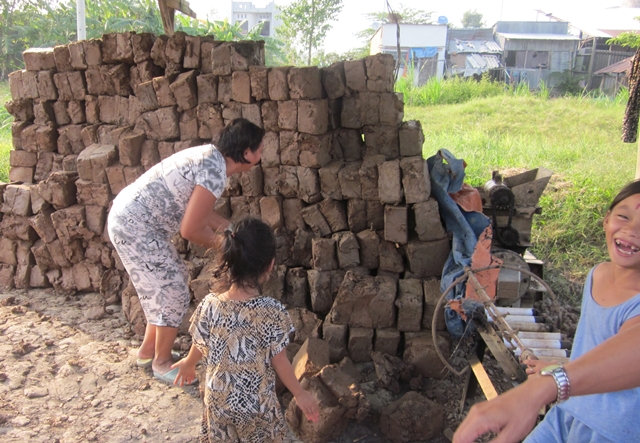
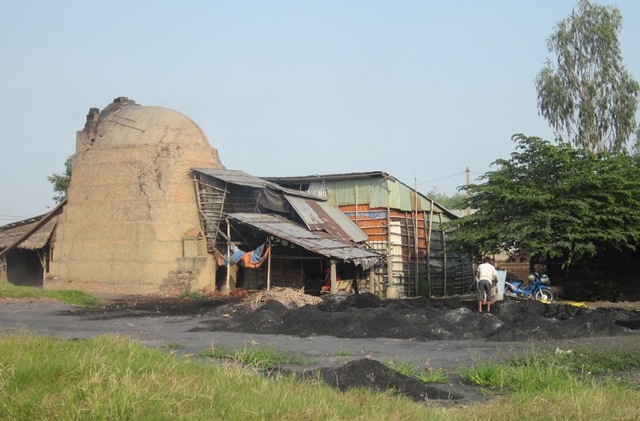
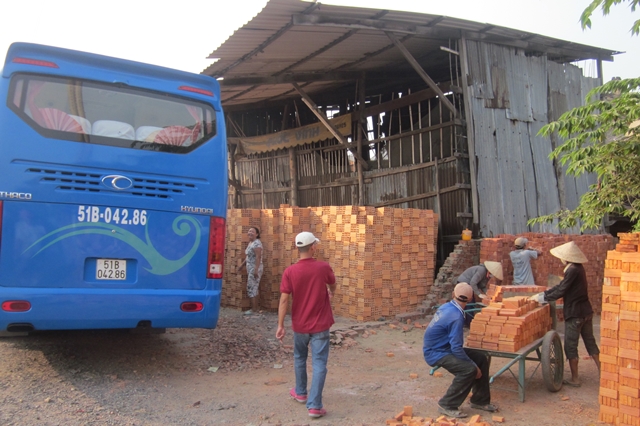 They use clay from the Mekong that is extruded in the machine on the right in the second picture. The bricks are air dried and loaded into a kiln and fired with rice bran. (The rice bran ashes are used as fertilizer). The bottom picture shows the finished bricks being stacked for shipment. It’s interesting that the grey clay turns orange when fired. That’s our bus on the left.
They use clay from the Mekong that is extruded in the machine on the right in the second picture. The bricks are air dried and loaded into a kiln and fired with rice bran. (The rice bran ashes are used as fertilizer). The bottom picture shows the finished bricks being stacked for shipment. It’s interesting that the grey clay turns orange when fired. That’s our bus on the left.
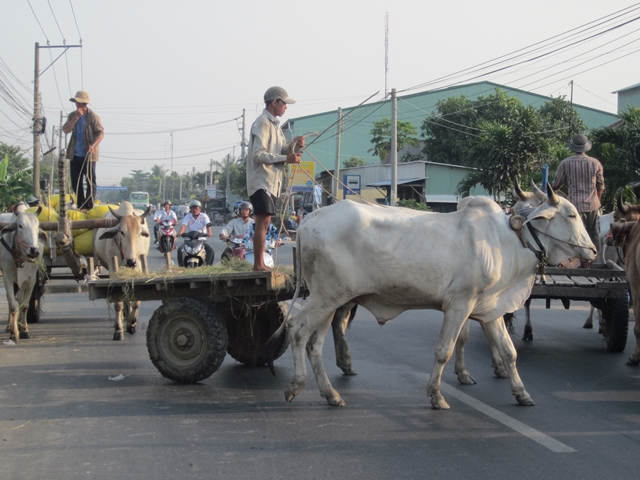 Brahman Bulls are used for pulling carts. These guys had just unloaded sacks of rice to be transported by barge up or down the Mekong. Theye are the yellow sacks in the rear cart. Old bulls become very tough steaks.
Brahman Bulls are used for pulling carts. These guys had just unloaded sacks of rice to be transported by barge up or down the Mekong. Theye are the yellow sacks in the rear cart. Old bulls become very tough steaks.

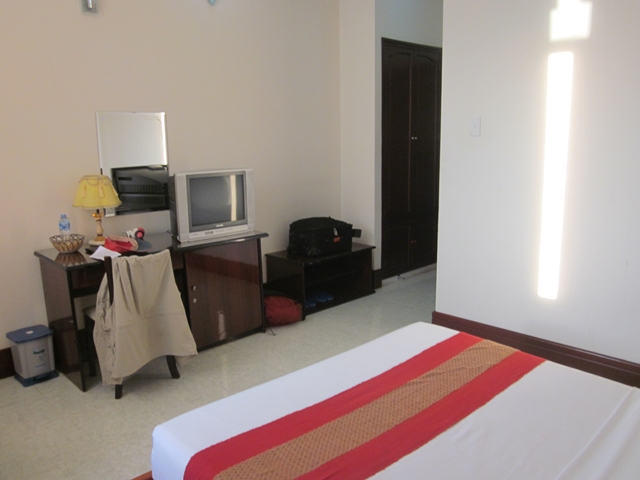 We were welcomed at the Dong Nam hotel in Chau Doc. Another nice room!
We were welcomed at the Dong Nam hotel in Chau Doc. Another nice room!
Dinner was at a home restaurant run by Ms Tui. 
 Our soup course was made with cassava, It looked good but was very bland and starchy.
Our soup course was made with cassava, It looked good but was very bland and starchy.
Cassava (aka manioc, yuca, and tapioca-root) is the third largest source of food carbohydrates in the tropics, after rice and maize. Cassava is a major staple food in the developing world, providing a basic diet for over half a billion people. It is one of the most drought tolerant crops, capable of growing on marginal soils. Cassava root is a good source of carbohydrates, but a poor source of protein. A diet consisting predominantly of cassava root can cause protein-energy malnutrition.
After dinner we went back to the hotel for the night! So ended Day 11.

